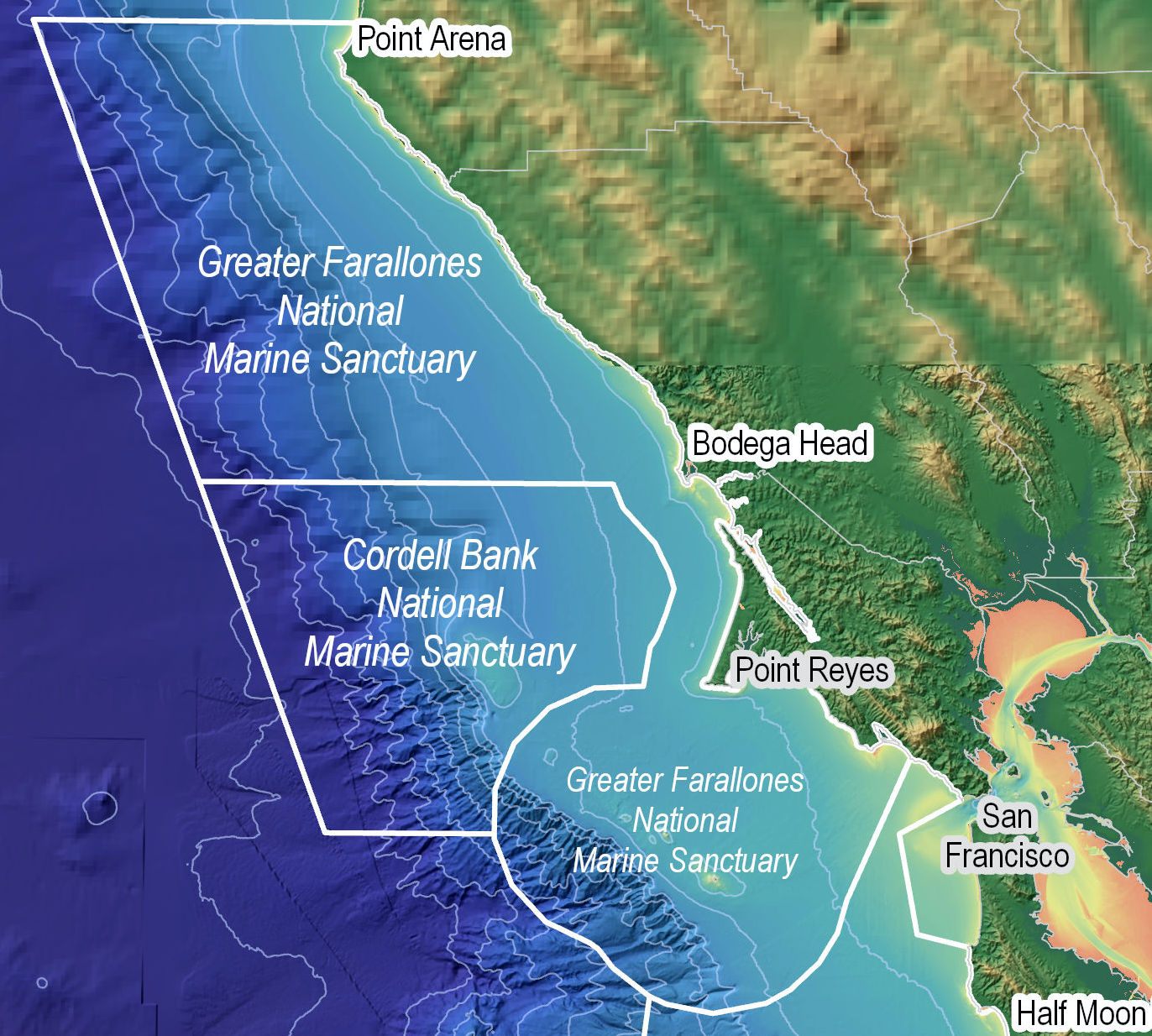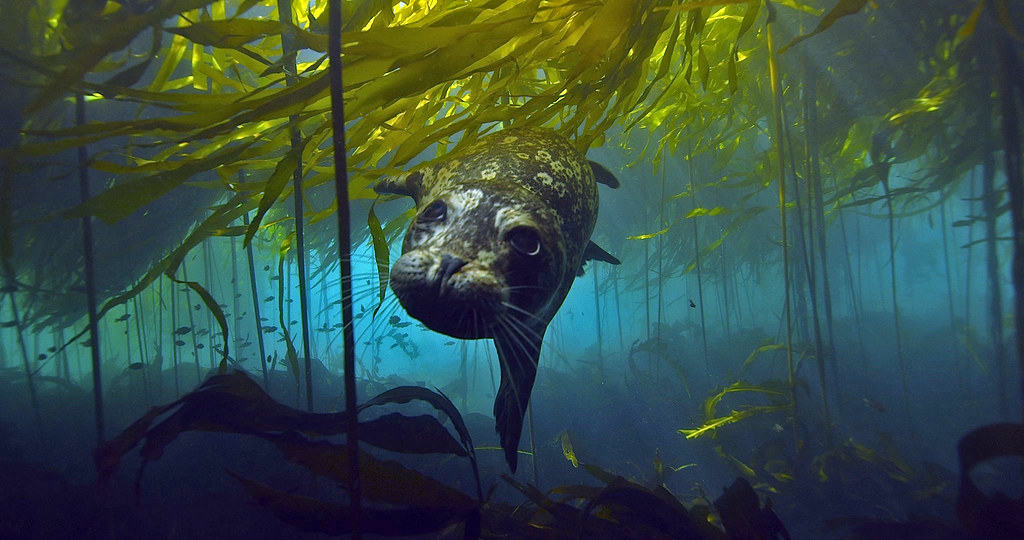By Tom Roth
Chapter Conservation Chair
Last summer will probably be remembered for COVID-19, wildfires, police killings of black Americans, and the uneven keel of our ship of state. And if we didn’t have plenty to choke on, climate change news continued to be evermore dire. A little known report, the Greater Farallones National Marine Sanctuary’s “2020 Climate Change Impacts,” was not a source of optimism.
The Greater Farallones National Marine Sanctuary (GFNMS) is a kind of oceanic national park made up of 3,295 square miles off the coast of five counties, including Sonoma and southern Mendocino. The sanctuary exists to protect our coastal waters, one of the planet’s most biologically rich marine ecosystems, and does so by banning offshore oil exploration, drilling and pipelines, pollution discharges, and damage to the seabed.
 GFNMS also invests in science and planning.
GFNMS also invests in science and planning.
“Science is behind every decision the sanctuary makes to protect resources,” says Dr. Wendy Kordesch, a geological oceanographer and a key member of GFNMS’ climate team. “We closely monitor the health of wildlife populations and ecosystems in our waters and use the latest climate science to develop plans to protect them.”
In 2010, the sanctuary, released its “Climate Change Impacts Report,” a document that has been emulated by all 13 National Marine Sanctuaries. The 2020 report, which relies on 72 scientific studies and reports, updates the 2010 document.
Both reports unsparingly look at a possible catastrophic future in the sanctuary.
According to the 2020 report, climate trends in the sanctuary in the last decade stayed the same, accelerated, or are already being realized. We are seeing the same rates as in 2010 for sea level rise, coastal erosion, nearshore water temperature, increases in extreme weather events, and climate impacts compounded by other human impacts. Impacts that accelerated faster than initially predicted include a decrease in spring runoff, rising sea surface temperature, and ocean acidification. Those now clearly observable are dryer dry years and wetter wet years, a northward shift in key species, and smaller and less nutritious phytoplankton.
If these trends continue, the beach and rocky inter-tidal habitats of stellar sea lions, elephant seals, and endangered western snowy plover (among others) will be drowned by rising seas. Inland we will see the destruction of salt water marshes—bird havens and important marine nurseries. Altered streamflow will affect the migration of salmonids. Warmer waters will lead to more frequent and intense toxic algae blooms. Acidic waters will eat away at shells and skeletons of mussels and deep sea corals. Dungeness crab will have reduced larval survival, and other sea creatures will starve as their prey diminishes. And yes, we humans will lose our beaches, many coastal roads and structures, recreational and commercial seafood sources, and much peace.
The big picture solution to climate change is a zero emission economy and removing carbon from the atmosphere. But at this stage, climate impacts are unavoidable, and so sanctuary staff and volunteers realized the necessity of adaptation strategies.
“Resilience and determination in our thinking are essential at this critical juncture. Climate change is a juggernaut already in motion that we cannot stop entirely, but we can slow it to buy time,” states Mary Jane Schramm, the sanctuary’s media specialist.
After looking at its climate vulnerabilities the GFNMS Advisory Council began in 2014 a two-year process to produce a Climate Adaptation Plan (CAP). According to Schramm, the sanctuary, and its partners, has conducted ecosystem monitoring for four decades, focusing on ocean indicator species—primarily marine mammals and seabirds—to produce long-term baseline data that enables detection of changes and preparation for the impact of those changes.
Six major strategies were chosen (implement living shorelines, promote education, protect and restore habitat, limit human disturbances, address invasive species, invest in science needs) as well as 26 sub-strategies. The CAP provided neither detailed plans nor resources—and some strategies were in fact novel and would require further research. But what the CAP provided was a framework of potential actions and priorities to create climate resilience in the sanctuary.
One sub-strategy highlighted in the CAP is to “Restore subtidal kelp forests to attenuate waves and buffer from enhanced storm activity.” Kelp forests are habitat for abalone and red sea urchins, as well as numerous fish and marine mammals. The central-north coast has experienced an estimated 90 percent loss of kelp sea beds in the last decade due to a chain of events that begins with a multi-year marine heatwave in the north Pacific and endures with huge populations of purple urchins devouring kelp forests.
The Sonoma-Mendocino Bull Kelp Recovery Plan, a product of the sanctuary and the California Department of Fish and Wildlife and supported by the Greater Farallones Association and numerous stakeholders and scientists, was released in 2019 and envisions two main strategies: reduce urchin grazing and culturing and the propagation of bull kelp. Urchin removal has started in Mendocino County and may soon begin in Sonoma County while Moss Landing Marine Laboratories is working on techniques for culturing and outplanting bull kelp.
Another offshoot of the CAP framework released in 2019, the GFNMS’s Coastal Resilience Sediment Plan, builds on previous collaborative work by state and federal agencies and NGOs. Increased erosion and reduced sediment renewal are caused by coastal development and impacts of climate change, such as sea level rise, bigger storms and increased wave height. The result is eroding cliffs, loss of beaches, sediment build-up in bays and estuaries, blockage of river mouths and damage to infrastructure. In the past, these problems have been addressed largely with “gray” solutions— the armoring of the shoreline with rip rap or sea walls. Gray stabilization unfortunately destroys habitat, shifts impacts elsewhere along the coast, and in many cases—Gleason Beach in Sonoma County, for example—falls apart under the unceasing pounding of the sea.
The GFNMS rejected gray solutions in the Sediment Plan and instead called for a living shoreline, using natural materials like rocks, sand and native plants to stabilize the coast.
“They are a ‘green’ alternative to ‘gray’ stabilization techniques (like sea walls) that are cheaper to construct, easier to maintain, more scientifically sound, and look like natural dunes or wetlands when they’re complete,” said GFNMS’s Kordesch.
Kordesch said, for example, Doran Beach in Sonoma County, a popular park located on a spit jutting into Bodega Bay, is rapidly losing its sand due to climate impacts. Bodega Harbor is periodically dredged and rather than dumping its materials into the ocean, tested clean sediments can be used to replenish the beach.
Kordesh added that watershed restoration efforts can slow sediment accumulation to help prevent flooding of waterways, such as at the mouth of the Russian River. A strategy like restoring coastal wetlands, can do “double duty,” she said. “Living shorelines in wetland habitats can stabilize the shoreline and sequester carbon at the same time. Wetland plants capture carbon through photosynthesis and sequester it in sediment where it can stay for thousands of years.”
The GFNMS’ formula for climate change adaptation—science-based decision making; partnerships and financial burden-sharing with government, academia and stakeholders; public outreach and education; and place-based strategies—will be tested in the future. The big question is, will our political system provide the needed resources as we race time to protect our irreplaceable marine ecosystems?